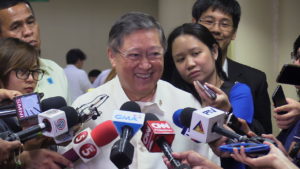President Duterte’s State of the Nation Address (Sona) on July 22 meant good news for agriculture. There were four important Sona agricultural recommendations made, which we must put in context.
After focusing on “Build, Build, Build” in the first three years of its term, the administration must, during its last three years, focus on “Grow, Grow, Grow,” specially in agriculture. With improved infrastructure, but without the other critical elements for growth, the farm sector cannot prosper.
For the last eight years, industry has grown at an average of 6.8 percent; agriculture, a measly 1.4 percent. Worse, in 2018, agriculture grew by only 1.1 percent, slowing further to 0.7 percent in the first quarter of 2019. This has resulted in rural poverty at 30 percent, more than double that of Thailand, Indonesia and Vietnam.
The four Sona announcements that can significantly improve this situation are as follow:
- On the creation of new department of water resources and a water regulatory commission. Agriculture uses 70 percent of our water. But since we only harvest 4 percent of our rain water compared to 60 percent in India’s key areas, droughts kill much of our agriculture. Furthermore, the 5.7 million denuded forest hectares cause soil runoffs that destroy our fields and further deplete our low water tables. Our 300,000 lost mangroves no longer protect us from flash floods and deprive us of needed fish for our fishermen’s livelihood. Ill-advised irrigation decisions further compound our agriculture problems.
All these involve coordination by different government agencies. But our 32 water-related agencies are not properly coordinated. The new department will address this problem.
However, it may take some time for legislation to take place. Therefore, it is hoped that the President will soon sign a presidential executive order with contributions from the Movement for Water Security and public-private sector groups, and ably guided by the National Economic and Development Authority. It will provide a structure for the needed agency coordination to take place, while waiting for the necessary legislation.
- On the passage of a National Land Use Act in 2019. This will regulate the use of our land and water resources, and classify land according to its use. Farmers, fisherfolk and investors need this law to provide stability and certainty on what the land will be used for. Consequently, short- and long-term plans can be formulated and implemented. Speculative real estate prospects will no longer take the place on the land needed for our food security.
- On the urgent utilization of the coconut levy fund, which now exceeds P100 billion. However, haste must not result in waste. The formulation of a professionally crafted coconut road map will ensure the optimal use of these funds. It is a tragedy that two out of our three million coconut hectares are mostly idle because nothing is planted between the trees. While we import more than 80 percent of our coffee and cacao, planting these products between the coconut trees will decrease our imports and increase the farmers’ incomes from P20,000 to P100,000 a hectare, with only a P60,000 investment. Working for added value instead of relying on low-priced copra can easily increase this income to more than P300,000.
- On Land Bank of the Philippines. He said, “Bumalik kayo where you were created for, and that is to help the farmers…or else I will ask Congress to reconfigure you.”
Credit has been the biggest problem of agriculture, where only 2 percent of loanable funds go to this sector. In 2017, Land Bank, which is the country’s agriculture bank, lent P62.5 billion to small farmers and fisherfolk and P84.8 billion to agri-agua businesses. However, this is only 22 percent of Land Bank’s P674.5B in loans. The reason is that Land Bank, if it wishes to retain its universal bank status, has to meet stringent financial criteria. This forces it to minimize the risk from agriculture lending. It is perhaps worthwhile for Duterte to now consider reconfiguring Land Bank from a universal bank to a true agriculture bank. This would then be similar to other countries’ agriculture banks, which do not have to meet a universal bank’s strict financial criteria.
The Sona has opened up at least four doors for agriculture to prosper. It is now up to the public and private sector to join hands and transform the Sona’s agriculture rhetoric into development reality.


